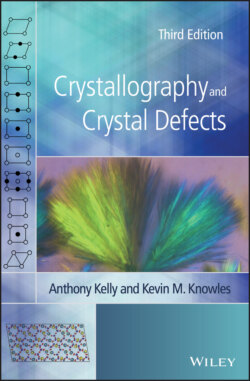Читать книгу Crystallography and Crystal Defects - Anthony Kelly - Страница 9
Preface to the Third Edition
ОглавлениеWhile there are a plethora of books devoted to crystallography and, in particular, X‐ray crystallography and electron crystallography of varying levels of sophistication, ranging from undergraduate primers to advanced research level texts, there is still no other textbook which cover the topics of crystallography and crystal defects in as integrated and complete a manner as previous editions of this book. As a consequence, unless there is one of these previous editions to hand, or, better still, this new edition, students and researchers interested in crystallography and crystal defects will have to have one or more sources for their crystallography, and one or more sources for their understanding of defects in crystalline materials and how the microscopic behaviour of the movement of dislocations or formation of twins leads to macroscopic plasticity in crystalline materials.
In this third edition, two new chapters have been created to extend coverage on texture and interphase boundaries, so that the book can continue to be both a useful learning resource and a source reference for senior undergraduates, graduate students and researchers on core aspects of crystallography and crystal defects of particular relevance to materials science. A number of sections of the book have also been either added or extended, such as the sections on magnetic groups, the elasticity of cubic crystals, dislocations in low symmetry crystal structures, atomistic modelling of twin boundaries, the description and classification of growth twins, modern theories of martensitic transformations and the mechanism of the shape memory effect in alloys which exhibit martensitic transformations. Original source references to key crystallographic terms familiar to materials scientists such as Miller indices, Bravais lattices, the Weiss zone law, and Miller–Bravais indices and Weber indices for hexagonal and trigonal materials have been included for completeness. New questions have been added to the end of each chapter where appropriate. As with the Second Edition, brief solutions to all the questions are given after the appendices, while full worked solutions are available at the password protected Wiley Web page accompanying this book at www.wiley.com/go/kelly/crystallography3e. In addition, a number of optical and electron micrographs illustrating various aspects of the microstructure of materials which follow from the theory outlined in this book have been uploaded to this password protected Wiley Web page.
Sadly, the senior author, Anthony Kelly, died on 3 June 2014, and so the responsibility for preparing this extended third edition has fallen entirely on my shoulders as the junior author. Therefore, any typographical errors either introduced during the preparation of this third edition or missed from the first two editions of this book are ultimately my responsibility. It will be evident from reading this book, and prior editions of this book, that the book is unashamedly not an introductory textbook to crystallography and crystal defects, even though it addresses fundamental topics in materials science. However, the aim in writing this third edition has been to continue to communicate both general background knowledge and specialist research knowledge in as accessible a way as possible to an audience educated to degree level, highlighting specialist textbooks, review papers and original research papers for those interested in a deeper understanding of the various concepts introduced. The contents of this third edition have been successfully used by me for two recent week‐long courses in the GIAN program run by the Ministry of Human Resource Development of the Government of India, one on crystallography for materials scientists aimed at advanced undergraduates and new postgraduates, and a more focused one on interfaces in materials for Ph.D. students and post‐doctoral research workers. Discussions with Professors Dipankar Banerjee at the Indian Institute of Science Bangalore, Rajesh Prasad at the Indian Institute of Technology, Delhi and Anjan Sil at the Indian Institute of Technology, Roorkee arising from these GIAN courses have all been invaluable in deciding what to include in this third edition, and at what level of sophistication. Rajesh Prasad deserves a special mention for highlighting a number of typographical errors in the second edition that I have now corrected in this third edition.
There are two colour images on the front cover of this book, both related to the crystallography of devitrite, Na2Ca3Si6O16. The larger of these is a low magnification photograph of devitrite needles nucleated on the surface of a block of soda–lime–silica float glass after a heat treatment of 17 hours at 850 °C observed in transmitted polarized light with a sensitive tint at 45° to the polarizer and analyzer, which are aligned vertically and horizontally, respectively. The needles are in a thin section cut perpendicular to the surface of the glass block. The edge of the sample is below the bottom of this photograph. I am grateful to Dr Robert P. Thompson from the University of Cambridge, Department of Materials Science and Metallurgy for permission to use this photograph. The second smaller colour image of atomistic modelling of a type II twin boundary in devitrite was produced by Prof. Bin Li, now at the School of Materials Science and Engineering, Sun Yat-sen University, Guangzhou, People's Republic of China. I am also grateful to Prof. Li for permission to use this image for the front cover.
Finally, as with the second edition, it is hoped that the reader whose understanding of crystallography and crystal defects goes well beyond what is described here will nevertheless find parts where his or her knowledge has been enriched.
Kevin M. Knowles
March 2020
